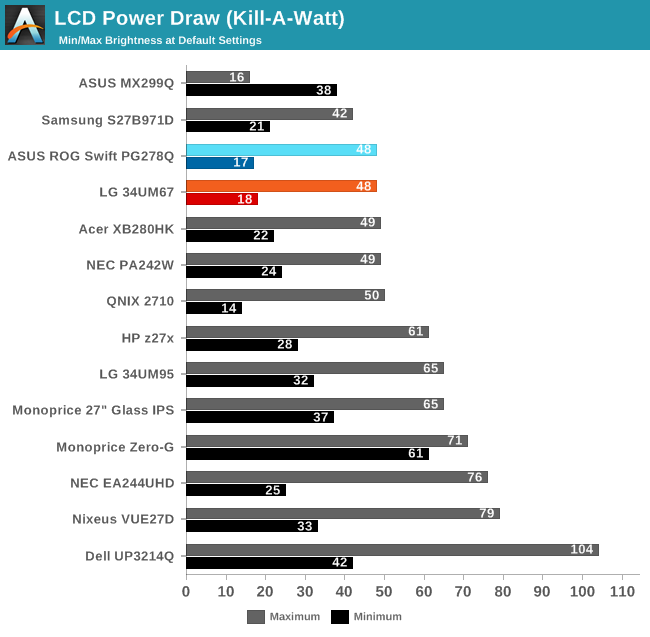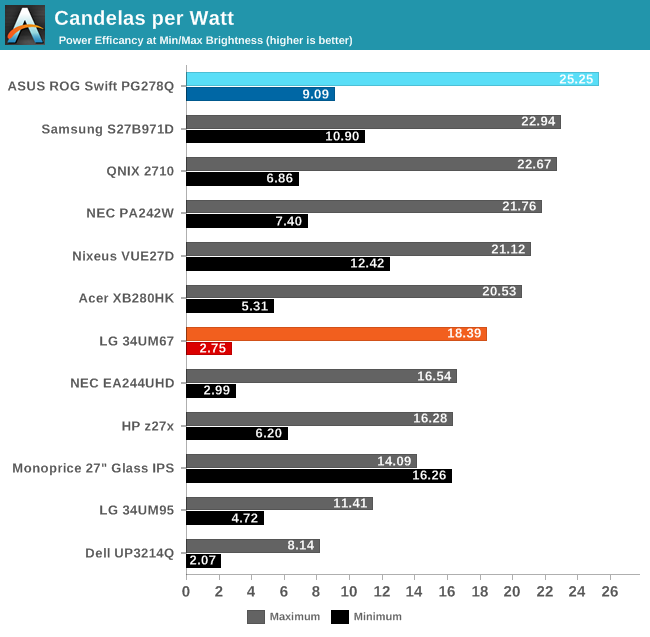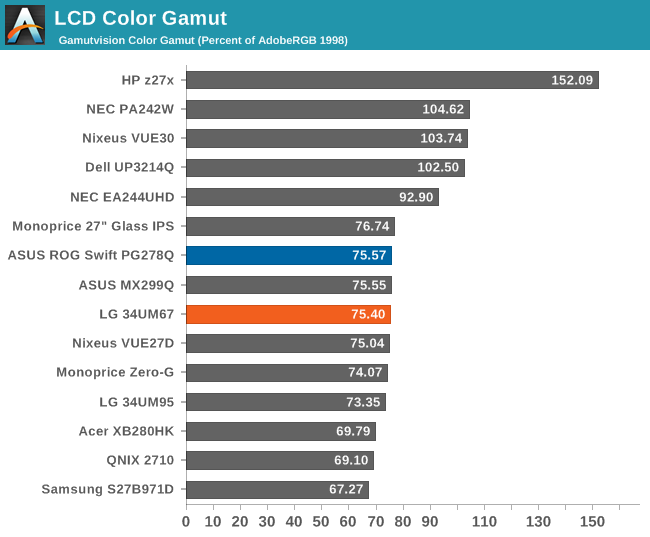LG 34UM67: UltraWide FreeSync Review
by Jarred Walton on March 31, 2015 3:00 PM ESTLG 34UM67 Power Use, Gamut, and Input Lag
With a full white screen and the brightness set to maximum, the LG 34UM67 uses 48 watts of power at the outlet. Setting the backlight to the minimum setting reduces this down to 18 watts. Targeting 200 cd/m2 meanwhile gives us a power draw of 35W. These results are really quite good for this size display.


The 34UM67 reproduces 75.4% of the AdobeRGB color space and 110% of sRGB (though some colors fall short while others are well above the sRGB spec). This is exactly what it sets out to do and is acceptable for a consumer-focused gaming display.

Input Lag?
As we lack the hardware to properly test for input lag, the only thing I can comment on is the experience. I’m not the best person for sensing input lag, though anything above 30ms or so definitely makes me notice. Having used several G-SYNC displays as well as many laptop displays over the years, I didn’t notice any issues with the LG display – if anything I’d say it was perhaps slightly more responsive than other (non-G-SYNC) displays I’ve used, perhaps thanks to the DAS feature. At least as far as input lag goes, there were no problems in my experience, and I’ve seen reports of ~10ms online which would agree with my subjective assessment. Other displays may show less input lag, but below 20ms it gets very difficult to notice.











96 Comments
View All Comments
Crunchy005 - Wednesday, April 1, 2015 - link
more unsupported rather than proprietary nature. Proprietary seems to get thrown around to much.p1esk - Tuesday, March 31, 2015 - link
Double the resolution, then get the price down to $499, and I will consider it.wolrah - Tuesday, March 31, 2015 - link
"the screen went black and never came back"*snicker*
Asmodian - Tuesday, March 31, 2015 - link
Isn't FreeSync disabled when over the VRR? Your in game (F1) ghosting test is with FreeSync disabled. What is the ghosting like with FreeSync active? I understand overdrive is forced off whenever FreeSync is active.JarredWalton - Tuesday, March 31, 2015 - link
Behavior over the max VRR depends on the game setting -- it can be either VSYNC on (which will effectively cap FPS at max VRR) or VSYNC off. I personally leave it off, as I like being able to run at higher FPS.Dribble - Tuesday, March 31, 2015 - link
And his other point about ghosting - on other freesync monitors overdrive gets disabled when freesync is on, is that the case here?JarredWalton - Wednesday, April 1, 2015 - link
I took plenty of ghosting pictures to check this out as much as possible. From what I can see, overdrive ("Response Time" in the LG OSD) is fully active with or without FreeSync.Soulwager - Tuesday, March 31, 2015 - link
"AMD tells us that they drive a display at its max refresh rate when the frame rate drops below the cutoff"Could you test that? PCPer said the display was staying at it's MINIMUM refresh rate when your framerate drops below the cutoff.
JarredWalton - Tuesday, March 31, 2015 - link
Sadly I don't have any equipment suitable for testing the actual refresh rate, which is why I say "claims". Right now, I'm pretty sure that if you fall below 48 FPS the display refreshes at 48Hz. I suspect it's something AMD can change with driver updates. We're still waiting of CrossFire FreeSync as well, so maybe the next driver update will alter the way this works.dragonsqrrl - Tuesday, March 31, 2015 - link
This is not a good variable refresh rate display, plain and simple. In fact I would argue it's not a good desktop monitor in general. I think the fact that this monitor even came to market illustrates the difference between Nvidia and AMD's strategy and design philosophy.